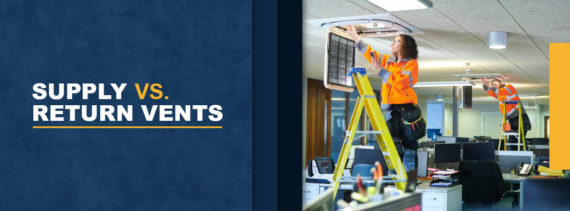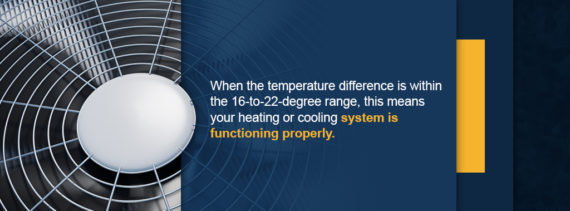Supply Vs. Return Air Vents
January 27, 2020
Hidden behind the walls of your home is a vast network of air ducts. They connect to virtually every room of your house and provide a pathway through which air can travel to and from your HVAC system. In this article, we’ll discuss the differences between supply and return vents and provide tips on how to maintain them.
What Is the Difference Between Supply Air Vents and Return Air Vents?
If your home has central heating and cooling, you’ll notice two types of vents on your walls.
- Supply vents: These are the vents that blow air into each room. The conditioned air goes from your air conditioner or furnace, travels through the ductwork and exits out the supply vents. These vents are easy to identify, as they’re the only vents from which you can feel conditioned air blowing out.
- Return vents: What is a return vent? These vents suck the air from each room and send it back to the air conditioning or heating system. Return vents tend to be bigger than supply vents, and you won’t feel any air coming from them. When an HVAC system delivers air to a room, it increases that room’s air pressure. Return vents exist to remove the extra air.
How Many Return Air Vents Do I Need?
Homes constructed before the advent of central air often have retrofitted HVAC systems. The earliest HVAC systems featured a large, single return vent placed somewhere in the middle of the home, but this is not the most effective system. Instead, there should be at least one return vent in every room, with two or three being ideal.
If your house has only one return vent, this is not a problem — make sure to keep the doors open in every room so the air can circulate properly. Make sure there are no furniture, draperies, rugs, etc. blocking return vents. If you ever need to replace portions of the ducts in your home, this may be a good opportunity to install a few additional return vents.
What Should the Temperature Difference Be Between the Supply and Return Vents?

While there isn’t any perfect temperature you should set your HVAC system to, there is an ideal temperature difference between the supply and return air, which should be between 16 and 22 degrees Fahrenheit. This difference in temperature is the evaporator Delta T.
When the temperature difference is within the 16-to-22-degree range, this means your heating or cooling system is functioning properly. If it is outside of this range, however, this means your system has a few problems.
In the case of air conditioning, the evaporator Delta T will tell you about the performance of your AC’s evaporator coil, which is the component responsible for cooling the warm air in your home. Here’s how you go about determining the Delta T for your system.
- Obtain a temperature probe: This device will provide a quick and accurate measurement of the surrounding air temperature.
- Record the return vent temperature: Take your temperature probe and record the return vent’s temperature.
- Record supply vent temperatures: Go to three supply vents and measure their temperatures.
- Determine the supply vent average temperature: Add the three recorded temperatures together and divide by three to get the average temperature of the supply vents.
- Determine Delta T: To figure out Delta T, subtract the temperature of the return air from the average temperature of the supply vents.
If the Delta T Is Too High
If the Delta T you calculated doesn’t fall within the 16-to-22-degree range, something about your AC system isn’t working correctly. If your Delta T is above 22 degrees, chances are that the airflow across your coil is too low, which can result from:
- A dirty air filter or evaporator that needs cleaning
- Ductwork that isn’t big enough
- A fan set to the wrong speed
To fix an AC system with a high Delta T, try one of the two following solutions.
- Replace the air filter: Doing so can often reduce the difference in temperature.
- Hire an expert: You can have a professional increase the speed of your blower motor, clean your coil and look for other potential issues with your system.
If the Delta T Is Too Low
If your Delta is less than 16 degrees Fahrenheit, the difference between your incoming and outgoing temperature is not high enough. This problem can result due to the following.
- Insufficient levels of refrigerant
- Leaky reverse valves
- Leaky AC return air ducts
- Weakening compressor valves
When it comes to the above issues, it’s best not to attempt to fix them yourself. Instead, hire an expert to check your system for leaky refrigerant and inspect your ductwork and valves.
Should I Put a Filter in My Return Vent?
Your HVAC system, just like any other piece of machinery, works best when free of dust and other debris. Debris can accumulate inside an HVAC system, like your AC unit’s evaporator coils.
While routine maintenance is a good idea, installing a return vent filter can help prevent this debris from entering your return vents and ensure the air entering your HVAC system is clean.
Your AC system also comes with a filter that purifies the air before it enters your equipment. A filter on your return duct, therefore, serves more like an additional precaution that helps further clean the air and extend the life of your HVAC system.
The Most Reliable HVAC Professionals in Southeastern Pennsylvania

At Summers & Zim’s, it’s our mission to keep Southeastern Pennsylvania homeowners comfortable through our variety of plumbing, heating and cooling services, including the following.
- Furnace replacement and repair: Anyone who has spent a winter in Pennsylvania knows a reliable furnace is necessary. That’s why so many homeowners in the area come to us when they need furnace maintenance or replacement.
- Boiler repair and installation: We also specialize in maintaining, repairing and replacing boilers. Visit our site to learn more about our boiler services.
- Air conditioner repairs and upgrades: Lancaster and Chester County homeowners also come to us to have their AC systems repaired or upgraded.
- Heat pump maintenance: Heat pumps are another popular system for cooling and heating in Pennsylvania. Learn more about the installation and repair services we offer for this heating system.
- Air quality testing: We also provide air quality testing services to make sure you have the right air purification system installed in your home.
- Well pump services: If you’re dealing with lower water pressure or your water isn’t coming out at all, your well pump is most likely to blame. Visit our site to find out more about our well pump repair and replacement services.
- Leaky bathrooms: Leaky fixtures and pipes can be a real pain to repair — and if you procrastinate on dealing with them, they can be costly as well. Learn more about our plumbing services.
If you’re a resident of Chester or Lancaster County and need any of the above services, feel free to reach out to us via our contact page.

